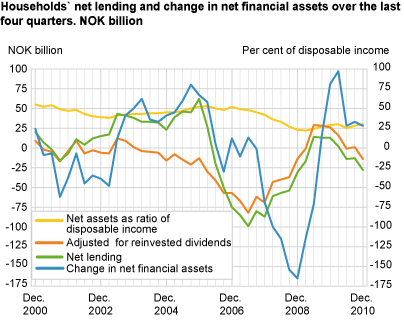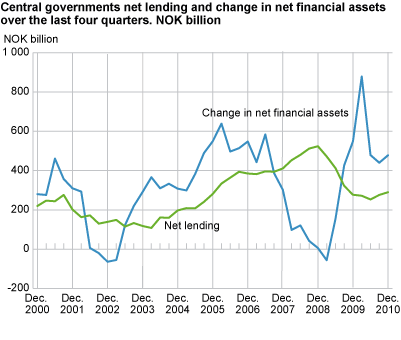Content
Published:
This is an archived release.
Net lending is falling
Households and non-profit institutions serving households increased their borrowing in 2010, while simultaneously reducing their financial investments. Net lending fell by NOK 40 billion from 2009 to 2010.
Households’ net lending is calculated to NOK -28 billion in 2010 compared to NOK 12 billion in 2009. Net lending increased to a preliminary top level in the four quarter period to the second quarter of 2009 with NOK 14 billion. In the last six four-quarter periods, net lending has had a decreasing development.
Households’ increased their debt
Last year, household borrowing was NOK 143 billion, which implies a growth in debts of 6.4 per cent in 2010. Borrowing has increased by NOK 27 billion from 2009, however only NOK 5 billion stems from growth in loans. Other accounts payable (short-term liabilities) contributed substantially to the development. Investments in financial assets amounted to NOK 115 billion, which is down by NOK 13 billion from 2009. The decline was due to the net acquisition of mutual fund shares, which almost stopped in 2010, after a net acquisition of fund shares of NOK 12 billion in 2009.
Households’ net financial assets increased by NOK 28 billion in 2010. Net financial assets are estimated at NOK 331 billion at the end of the fourth quarter of 2010. Net financial assets at the end of 2010 constituted to 74 per cent of net financial assets at the end of the second quarter of 2010, before financial turmoil caused large net losses.
State’s net financial assets increased to record high levels last year
Central government’s net financial assets increased to a new preliminary top level at the end of 2010. The development is explained by higher net lending and large net holding gains. Net lending summarised over four quarters fell from the fourth quarter of 2008 to the second quarter of 2010, but increased during the two last quarters of 2010. Net lending is summarised to NOK 290 billion in 2010, which is NOK 13 billion higher than in 2009. Together with net holding gains of NOK 188 billion last year, this contributed to increasing the central government’s net financial assets by NOK 478 billion. At the end of 2010, net financial assets amounted to NOK 4 286 billion.
High and stable borrowing in local government
Local government’s net lending shows a pronounced fall in 2010. This is explained by declining investments in financial assets and high borrowing at a continued high level; almost on a par with borrowing in 2008 and 2009. The local government borrowed NOK 38 billion in 2010, which is a modest increase from 2009. The development in borrowing can to a large extent be explained by non-financial investments in counties and municipalities (roads and buildings). At the end of 2010, total debt in local government is calculated to NOK 421 billion.
Net lending abroad up in the fourth quarter of 2010
Norway’s net foreign assets were calculated to NOK 2 358 billion at the end of the fourth quarter of 2010. This is up by NOK 106 billion from the end of the third quarter of 2010. Norway’s net lending abroad was NOK 91 billion in the last quarter, which is up by NOK 22 billion from the third quarter. Net holding gains due to exchange rate developments in foreign exchange and global security markets increased the value of net financial assets abroad by NOK 15 billion in the fourth quarter of 2010.
| 3. quarter 2008 | 4. quarter 2008 | 1. quarter 2009 | 2. quarter 2009 | 3. quarter 2009 | 4. quarter 2009 | 1. quarter 2010 | 2. quarter 2010 | 3. quarter 2010 | 4. quarter 2010 | ||||||||||||||||||||||||||||||||||||||||||||||||||||||||||||||||||||||
|---|---|---|---|---|---|---|---|---|---|---|---|---|---|---|---|---|---|---|---|---|---|---|---|---|---|---|---|---|---|---|---|---|---|---|---|---|---|---|---|---|---|---|---|---|---|---|---|---|---|---|---|---|---|---|---|---|---|---|---|---|---|---|---|---|---|---|---|---|---|---|---|---|---|---|---|---|---|---|---|
| Financial assets | 5 801 | 6 465 | 5 974 | 6 162 | 6 161 | 6 153 | 6 471 | 6 798 | 6 737 | 6 958 | |||||||||||||||||||||||||||||||||||||||||||||||||||||||||||||||||||||
| Liabillities | 4 385 | 4 917 | 4 601 | 4 453 | 4 265 | 4 265 | 4 380 | 4 616 | 4 485 | 4 599 | |||||||||||||||||||||||||||||||||||||||||||||||||||||||||||||||||||||
| Net financial assets/net financial wealth | 1 415 | 1 548 | 1 373 | 1 710 | 1 895 | 1 889 | 2 091 | 2 182 | 2 253 | 2 358 | |||||||||||||||||||||||||||||||||||||||||||||||||||||||||||||||||||||
| Change in net financial assets/net financial wealth | 207 | 133 | -175 | 337 | 186 | -7 | 202 | 92 | 70 | 106 | |||||||||||||||||||||||||||||||||||||||||||||||||||||||||||||||||||||
| Other changes | 102 | 5 | -242 | 252 | 119 | -99 | 114 | 18 | 2 | 15 | |||||||||||||||||||||||||||||||||||||||||||||||||||||||||||||||||||||
| Net lending | 105 | 127 | 67 | 85 | 67 | 92 | 88 | 74 | 69 | 91 | |||||||||||||||||||||||||||||||||||||||||||||||||||||||||||||||||||||
DefinitionsNet lending as defined in non-financial accounts (capital account) = savings + net capital transfers - net acquisition of non-financial assets Net lending as defined in financial accounts = net acquisition of financial assets - net incurrence of liabilities Savings is non-consumed income and can be invested in financial or non-financial assets. If savings exceed non-financial investments, a sector has a surplus of funds and becomes a net lender to other sectors. In the financial transaction account, this means that the sector acquires more financial assets than liabilities. On the other hand, if savings are less than non-financial investments, investments have to be funded either by selling financial assets or incurring debts. Household investments in non-financial assets mainly reflect the purchase of new housing and fixed investments by unincorporated enterprises. They typically finance substantial parts of these investments by incurring debt in the form of loans. Net financial assets (net financial wealth) = total financial assets - total liabilities The financial balance sheet shows the financial position of a sector at the end of the reference period and is broken down into the categories of financial assets and liabilities. Insurance technical reserves, currency and deposits are the predominant assets held by households, while loans provided by financial corporations (banks etc.) constitute the main proportion of liabilities. Changes in net financial assets = net lending + other changes in assets, net The change in the financial balance sheet during the reference period is a result of accumulated financial transactions and other changes in assets. The latter category mainly reflects revaluations due to changes in market prices of financial instruments. |
Contact
-
Torbjørn Cock Rønning
E-mail: torbjorn.cock.ronning@ssb.no
tel.: (+47) 97 75 28 57
-
Jon Ivar Røstadsand
E-mail: jon-ivar.rostadsand@ssb.no
tel.: (+47) 21 09 43 69
-
Marit Eline Sand
E-mail: marit.sand@ssb.no
tel.: (+47) 40 90 26 74


